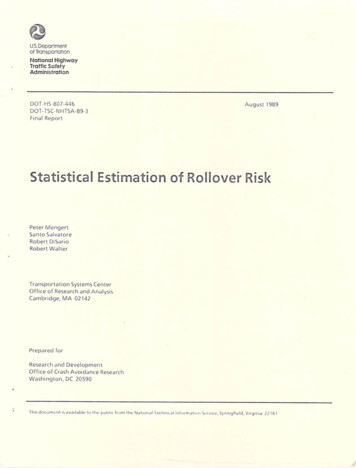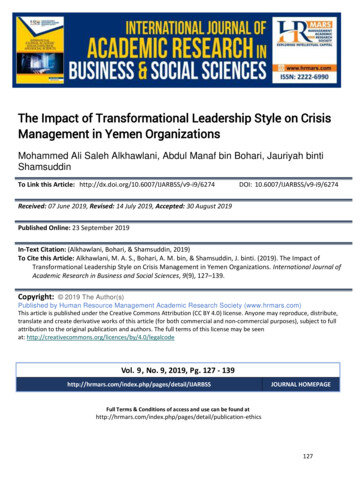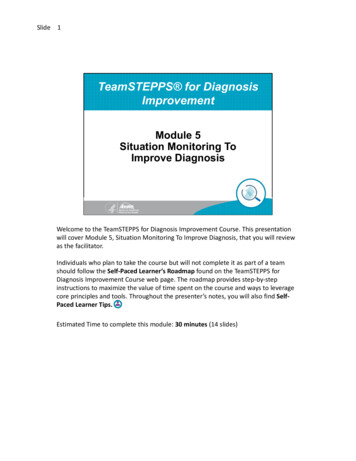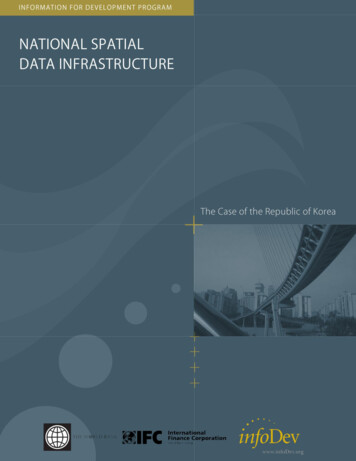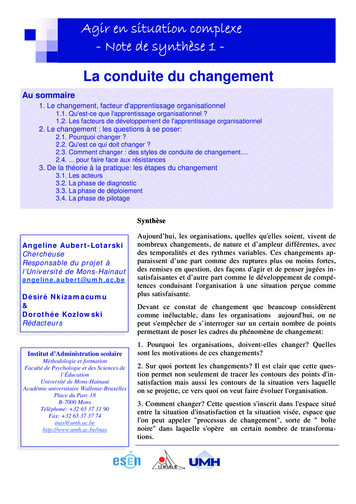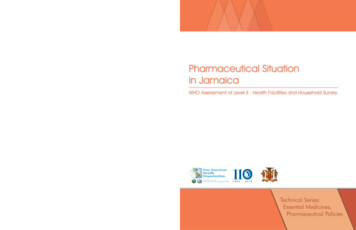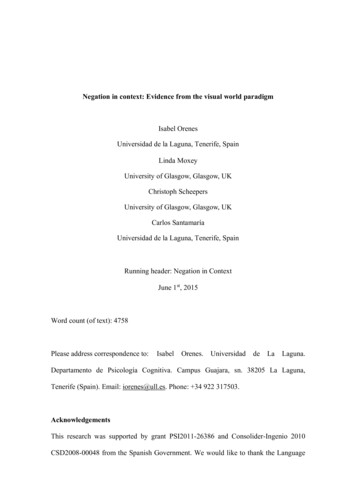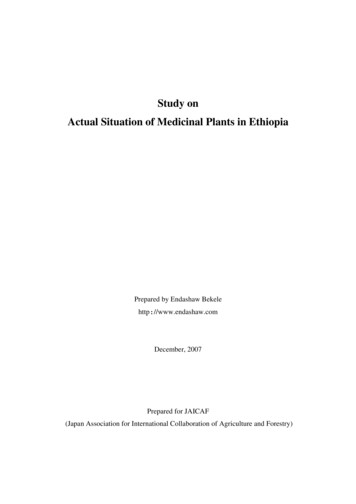
Transcription
Study onActual Situation of Medicinal Plants in EthiopiaPrepared by Endashaw Bekelehttp://www.endashaw.comDecember, 2007Prepared for JAICAF(Japan Association for International Collaboration of Agriculture and Forestry)
Table of ContentsExecutive summary. .11. Introduction.132. Definition of "medicinal plants" in the project being studied. .153. Contents of the study. .164. Overview of medicinal plant situation in Ethiopia . . 165. Medicinal plant diversity and distribution in Ethiopia. .186. The traditional medical system and medicinal plant resources in Ethiopia.207. Current Government Policy on medicinal plants development goal .228. Accounts of the traditional medicinal plant species of Ethiopiaand its current situation . . .279. Sources of supply of medicinal plants .3110. Trade in medicinal plants . 3211. Classification of medicinal plants and ailments treated .3512. Sustainable medicinal plant utilization and conservation . 3613. Overview of medicinal plant industry, relevant experienceto promote this sector in Ethiopia . .3914. International market of medicinal plant.4015. Future scenario of medicinal plant in Ethiopia. 41a. Acquisition and transfer of indigenous knowledge on traditional medicine.41b. Future prospects of traditional medicine.4216. Strength, Weakness and Opportunities (SWOT Analysis) in medicinal plantsector.42a. Strength. 43b. Weakness. 43c. Opportunities. 43d. Threats.4417. Strategies for Improving the Role of Traditional Medicineand practitioners.4418. Conclusion and recommendation.4619. Cultivation and mode of production of some medicinal, root, tuber,vegetables, Industrial crop, herbs and spices.47Reference list.66
AcronymsAAUAddis Ababa UniversityBCBefore ChristCaAboutCIDACanadian International Development AgencyESTCEthiopian Science and Technology CommissionETBEthiopian BirrIARInstitute of Agricultural ResearchIBCRInstitute of Biodiversity and Conservation ResearchIFSInternational Foundation for ScienceIHNInstitute of Health and Nutrition studyIUCNInternational Union for ConservationNGONon-Governmental OrganizationMOHMinistry of HealthRPOResearch and Publication OfficeSARECSwedish Agency for Research and EducationSWOTStrength, Weakness, Opportunity and Threats
Executive summaryThe Objectives of the present study include relationship between human andmedicinal plants in Ethiopia in terms of these plants’: usage collection/production conservation and growth situation constraints and potentialThe contents of the study include:-- Current situation and recent trends in medicinal plants’ sector development inEthiopia.--Historical overview and recent trends regarding medicinal plants in Ethiopia.--Geographical overview of growth of medicinal plants in Ethiopia--Salient features of usage of medicinal plants in Ethiopia--Salient features of access to medicinal plants by Ethiopian people.--Differentiation of usage and access to medicinal plants according to various ethnicGroups-- Introduction of some specific medicinal plants where at least 1 herb, 1 spice in 5Plants are included in terms of:-Conservation-Collection/ production-Distribution-UsageThe cultivation and use of spices, herbs, medicinal and other essential oil bearing plantsis not new to Ethiopia. It is as old as the crop themselves, and its history can be tracedback to the reign of Queen Sheba (ca.992 BC). Ethiopia is the origin and/or center ofdiversity for many of these plant speciesThe various literature available show the significant role of medicinal plant in primaryhealth care delivery in Ethiopia where 70% of human and 90% of livestock populationdepend on traditional medicine similar to many developing countries particularly thatof Sub-Saharan African countries. The traditional health care is culturally deep rooted1
with oral and written pharmacopoeias.Ethiopian plants have shown very effective medicinal value for some ailments ofhuman and domestic animals thus medicinal plants and knowledge of their use providea vital contribution to human and livestock health care needs throughout the country.Such plants include Phytolacca dodecandra and many species of Maytenus. The majorreasons why medicinal plants are demanded in Ethiopia are due to culturally linkedtraditions, the trust the communities have in the medicinal values of traditionalmedicine and relatively low cost in using them. This is acknowledged for example by aresult of recent study that was conducted and showed that the value of both importedand domestically produced pharmaceutical products were about ETB 1.05 billion.During the same year the value of medicinal plants including traded and non tradedones was ETB 423 million making average health coverage of 42% of Ethiopianexpenditure on pharmaceutical products. This is not only a significant saving in termsof foreign currency but also availability assurance for the primary health care systemsin the rural community. The volume of sales of medicinal plants has increased overyears and this has been taken by some as the existence of disease prevalence requiringtraditional Medicare causing increased demand which led to harvesting importantmedicinal plants. The expected increase in the cost of commercial drugs and theiroccasional impotency also increase demand of medicinal plants. The proportion ofconsumers who rely on harvesting medicinal plant is the highest in the rural area, sincecollecting from natural plantation is most accessible and cost affective.There are 6500 species of higher plants in Ethiopia making the country one of the mostdiverse floristic regions in the world. There are large numbers of moderate to high valuemedicinal plants herbs and spices existing in the wild. However, of the existingmedicinal herbs and spice plants only small % are traded. Being a land of diverseclimatic and edaphic potentials, several of such indigenous and exotic species andessential oil bearing plants could luxuriously grow in Ethiopia and provide remarkablebenefits to the national economy. However, so far only two of the major 18agro-ecological zones defined as hot to warm humid lowlands and Tepid to cool humidmidlands carry out some research and production activities of some herbs, spices andrelated aromatic plants.2
The research made so far on Ethiopian medicinal plants has been mostly of producinginventories and checklists, some have been touched by modern research where theirprincipal component has been analyzed and defined.The bulk of the plant matter used for medicinal purposes is collected from naturalvegetation stocks that are shrinking with degraded environment and is faced tosubstantial reduction or dwindling of species of medicinal plants.Different vegetation types that are found in the various agro ecological zones ofEthiopia accommodate various types of medicinal plants. The available reports showthat the woodlands, the montane vegetation including grasslands and forests and theevergreen scrubs and rocky areas contain more medicinal plants with higherconcentrations in the woodlands. These reports indicate that the microphylousvegetation of the wood lands contain more medicinal plants species followed by themontane grassland and riverine vegetation while the Afro alpine vegetation are the leastof the group.Ethiopian traditional life is painted with the hallmark of widespread use of traditionalmedicinal plants with various levels of sophistication within the indigenous medicinallore. It is blended with religious thinking and various beliefs and need furtherinvestigation. The basic categories of practitioners also are difficult to define.Some have described the traditional medical system of Ethiopia as medico-religiousSystem (Dawit Abebe and Ahadu Ayehu, 1993) and others as Magical religious. Suchdescription is due to close interaction of the Christian, Islamic and indigenous religionswith the traditional medical system in the country which sometimes displays featuresrelated to magic, beliefs and faith in some areas. However, the enigmatic nature of themedical system does not make such relations clear in some parts of the country.Ethiopian peoples have their own set of written and or oral pharmacopoeias with themedicinal use of some species being restricted to each ethnic group. The cultural andindigenous knowledge of medicinal plants in Ethiopia is unevenly distributed amongeach community members. Peoples in different zones/location with different religious,linguistic and cultural backgrounds have their own specific knowledge about use ofplants which in part has gradually entered wide circulation in the country. Theknowledge on medicinal plants is largely oral, however, Ethiopia’s ancient church3
practices have documented some of the knowledge as inscribed in Parchments whichpartly characterize the traditional medical system usually described as medico religiouswritten in Geez manuscripts of the 15th century (Gelahun Abate, 1989; Dawit Abebeand Ahadu Ayehu, 1993). Other ancient written sources include the book of remedy(Metsehafe Fews) of the 17th century which contains a wide range of medicinal plantsprescription (Fekadu Fullas, 2001). These are the medical traditions of the followers ofCoptic Christianity. Other cultural groups in the country have their own written or oraltraditions that could be associated with individual clans or groups as partly stated byAmare Getahun (1976) and Abbink (1995).1000 identified medicinal plant species are reported in the Ethiopian Flora, however,many others are not yet identified. About 300 of these species are frequently mentionedin many sources. The greater concentration of medicinal plants are found in the southand south western Ethiopian parts of the country following the concentration ofbiological and cultural diversity (Edwards, 2001). The various citations made fromvarious written records of medicinal plants from central, north and northwestern part ofEthiopia are thus small fractions of medicinal plants present in Ethiopia. Very recentstudy on the Bale Mountains National Park in the South East Ethiopia revealed that thearea, as much as it is a biodiversity hotspot, also turned out to be a medicinal planthotspot with 337 identified medicinal species of which 24 are endemic (NationalHerbarium, 2004; Ermias Lulekal, 2005; Haile Yineger, 2005). The species comprisedof 283 used as human medicine, 47 used as livestock medicine and 76 species used forboth human and livestock by the community healers, harvesters, traders and users. Thiswork further suggested spots that could be considered medicinal plant micro - hotspotswithin the Bale Mountain area. The serious work on the Ethiopian flora with sevenvolumes published so far is not yet complete and hence the present figures and plantlists reported can not be taken as a final.Some medicinal plant species of Ethiopia are reported to have been threatened by theoveruse and over harvesting for marketing as medicine. A good example is Tavernieraabyssinica whose slender roots that are swathed and small coiled bundles presented formarket.Environmental degradation, agricultural expansion, loss of forests and woodlands,over-harvesting, fire, cultivation of marginal lands, overgrazing and urbanization4
appear to be the major threats to the medicinal plants of Ethiopia. Endemic medicinalspecies restricted to Ethiopia are of primary concern to Ethiopia and to the world aswell and thus need serious attention.The distribution of knowledge and services of medicinal plants are hierarchicallyplaced. Services are obtained from the family, the neighborhood, the village or beyond.Further more there is very little ethno botanical documentation on most medicinalspecies of the country. The status of phytomedicine, preparation of crude extracts andisolation of active principles is very minimal. The data base for the recorded species ofmedicinal plants also needs special attention.There is research made in the higher learning institutions on several aspects ofmedicinal plants in Ethiopia. Most studies on medicinal plants made, however,remained more of a survey nature and the outputs were mere listing of plants used asremedies for various ailments usually with incomplete description and mainly withuncertain recipes. But yet there are useful reports that can be cited.Medicinal plants obtained from wild habitats are found in different natural ecosystemsof the forests, grasslands, woodlands, wetlands, in field margins and garden fences, asweeds and in many other microhabitats from where they are harvested when the needarises. These are free access resources to all who want to use them for the family forpracticing traditional medicine or for sales. In the traditional market place in Ethiopia,medicinal plants are usually associated with spices and herbs. They have to be lookedfor in the areas of the market where spices and herbs are displayed on roadsides duringreligious ceremonies around churches and mosques. In Ethiopia, the informal tradetakes the major share in rural areas except at the level of healers who commercializejust the crude materials or charge together with the treatment they provide upon theirdiagnosis.Although woodlands are where most of the medicinal plants are present, its resourcecapacity with reference to others, need to be worked out. The key issues to be engagedin this process include: The requirements of the users, i.e. demand for the resource The size and conditions of the resource5
The part of the plant that is harvested i.e. whether the harvesting is likelyto kill the plant The response of the species to different harvesting practices Production and recovery rates of the species and affected habitat The options that are available for development of alternative resourcesand Land and resource ownership systems.In the absence of regulatory control, product quality is variable. Inadequatepost-harvest storage and processing techniques often lead to high levels of microbialcontamination and significant stock/losses. Little attention is paid to product packagingand marketing, and the most significant value-adding takes place when the remedies areprescribed by traditional healers. Consumer safety is also an issue, although largelyunmonitored at present.In the country side, people may access medicinal plants products through informalinformation networks in addition to market days which take place weekly or twice aweek. In rural areas of Ethiopia, medicinal plants treatments could also be given free ofcharge but some token is believed to be in order for the medicine to take effect. In ruralareas of Ethiopia self medication using indigenous medicine, is the cheapest and mostlythe only form of healthcare available. Friends, relatives and neighbors providetraditional treatment free of charge or paid in more flexible arrangement such aspayment in cash or kind and on a credit basis. This is specifically prevalent in ruralcommunities. The domestic supply sources are closely associated with the biodiversityand concentration of forest areas e.g. Jimma, Bale. Traders from Dire Dawa forexample travel as far as to Bale, Jimma, Gonder, Menz, Assosa etc. to buy differenttypes of medicinal plants.Ethiopia has policies and strategies that support the development and utilization ofplant resources in a sustainable manner. The policies are reflected under varioussectors including environmental protection, development of the natural resources anddiversification of the domestic and export commodities. The country also hasdeveloped policy and a guide line for intellectual property rights protection of6
traditional medicine. The policy encourages and promotes the appropriate use andprotections of traditional medicine knowledge in Ethiopia taking in to account the needof the traditional medicinal knowledge holders and the communities who benefit fromthe use of the knowledge. Medicinal plants fit in the development activities that supportpublic efforts in meeting livelihood requirements. There are few institutions concernedwith the medicinal plants and assisted through government budgetary support.The status of phytomedicine, preparation of crude extracts and isolation of activeprinciples in Ethiopia is very minimal. The data base for the recorded species ofmedicinal plants also needs special attention. There are however, differences in termsof prevalence of use of species overtime. e.g. T. abyssinica has now declined mainlybecause of over-harvesting and degradation of wild bush lands in Shewa and Tigray(Mesfin Tadesse, 1991).Except in a few cases where a few food crops with medicinal value are cultivated, thereis no organized cultivation of plants species for medicinal purposes in Ethiopia. Thereason for this is that the quantities of medicinal plants traded are very small, and thereis no organized large scale value addition and processing. However, there is a potentialin the future for increased demand for some of the species and, therefore, it is importantto identify them and start the necessary research on the propagation and cultivationtechniques. Such program will also provide basis for small enterprises to improve theincome generating capacity of the local people.As the treatment of specific disease involves numerous plants and different house holdsuse different plant mix and there are variation across households in preferences, thecultural set up promotes not only conservation but also diversification of theseresources. Increasing the population and diversity of medicinal plants in home gardensand other areas outside forests is a solution for avoiding human disturbance of forestsand the supply shortage that usually goes with seasonal variation.Marshall (1998) reported that Ethiopia had no legal export and import of products formedicinal use but plants of medicinal importance are exported to Djibouti and othercountries as agricultural products.The recent World Bank supported project on medicinal plants has the following7
sub-components with the participation of IBCR, AAU, IHNS, ESTC Regionalgovernment of Oromia. Their work on the World Bank supported Medicinal Plantproject have yielded Development of Intellectual property Guidelines Establishment of Database of medicinal plants Extraction, standardization, safety, Efficacy and dosage formulationon very few species not exceeding 3 to 4. In situ Conservation and sustainable use of medicinal plants withfield gene banks in Bale Mountains and Wondo GenetThe researches made in the higher learning institutions on several aspects of medicinalin Ethiopia include: physicochemical studies, isolation of anti-parasitic, analgesic,molluscidal, insecticidal properties of some medicinal species with somestandardization and tablet formulation of plant extracts.In addition to the above lists the Department of Drug Research at Ethiopian Health,Nutrition Research Institute gives the following research out puts (Dawit Dikasso,2007, personal communication) screening in vitro, in vivo antibacterial, antifungal and antiparasitic activity oflocal medicinal plants medicinal plants for their efficacy and safety evaluation of traditional anti-malarial, anti-helmintic, anti-hypertensive and anti-diabetic medicinal plants dosage form development from therapeutically established herbal remedies on crude extracts containing bioactive compounds compilation of check lists of medicinal plants of EthiopiaThe overall review shows that research areas in the study of medicinal plants are verylittle. The answers to the following questions are still pending: What are the potential forest plants that could be grown on farm to generateincome? How does the export market for medicinal plant products operate?8
Research in filling existing gap in knowledge regarding the biology andtechnical options for species as well as methods of harvest, species quantities,zones, seasons, extractable level, yield etc what are the ecological factors governing natural regeneration of woodyspecies. availability, status of soil, seed bank, edaphic factors, forestdisturbances, the level of extractionand extraction zones and seasonalvariationBasic research on propagation and agronomic practices are practicallynon-existence What are the medicinal plant species with high market demand and value? What are the cultivation technology, quality standards, cost production, incomeand profits of suitable varieties marketed?The above problems of research should focus on those medicinal plants that are widelyused by the society. Some times a single species of plant may appear in manytreatments and alternatively various species can be used for the same treatment asexemplified by Hygenia abyssinica , Glinus lotoides and Embelia species.Plantations of medicinal plants can be made in degraded and degrading areas. There aremany medicinal plants of Ethiopia that have good properties for land rehabilitation anderosion control which could be planted in different agro ecological settings. Goodeconomic opportunities exist in both the developed and developing countries as marketare showing increasing growth, mostly as a result of increasing demand. Ethiopia hasthe potential to become an important source country, given the diversity of plants andthe rich traditional knowledge regarding their use as medicine.The issue of medicinal plant conservation in Ethiopia today calls for aggressive studiesand documentation before the accelerated ecological and cultural transformation distortthe physical entities and the associated knowledge base. Sometimes the same plants aregiven different names because of differing expressions of the same species at differentareas by different people and due to different languages, dialects and cognates.Innovative options like eco agricultural, maintenance of traditional farming systemsand linking conservation with utilization by community need to be carefully developed9
and implemented.SWOT analysis show that there are many strong points and opportunities to make thesector more productive and improve the livelihood of poor farmers and people ingeneral.The sector also has weakness and threats that need to be checked. The strength of thesector include: rich biological diversity of medicinal plants; existence of valuableindigenous knowledge with established tradition and healers. The weakness of thesector include: secrecy of indigenous medicinal plants knowledge; limitedconservation activities and little scientific studies on medicinal plants; poor marketinformation system and market infrastructures; lack of public-private sector investment.The country has no well developed technology infrastructure capacity to engage inproduct development. Nor it has efficient new production systems and active trade.Product development has been minimal. Supply chains are poorly developed with lackof effective trade network.The strength of the sector overweighs its weakness with the following opportunities:enhancement of economic benefits with employment opportunities; preservation ofcultural and natural assets with the improvements of health care systems.The following strategies for Improving the Role of Traditional Medicine andPractitioners can be followed: Identification and registration of the traditional medicine practitioners;Assess the need for training of the selected and registered traditionalmedicine practitioners and designing appropriate skill upgrading trainingprograms;Encouraging the formation of a strong National Association for traditionalmedicine practitioners,Introduction of the role and importance of traditional medicine to the publicThose plants that are harvested for their roots, tubers and bulbs need special attention ofconservation. Such attentions should be extended to the woodlands of Ethiopia whichare the sources of most of the medicinal plants followed by the Montane grassland/dryMontane forest complex. To salvage indigenous knowledge from disappearing, theyoung generation has a very crucial role to play. Accordingly, it is highly recommended10
to include in the school curriculum aspects of traditional medicine and medicinal plants.Based on the various surveys, following the objectives of the study several conclusionsand recommendations are given. Also emphasis are given that research on medicinalplants should be in line with Primary Health Care system of the country and shouldaddress the disease prevalence in the country like respiratory infections, diarrhoeal,malaria, tuberculosis, sexually transmitted diseases, trypanosomiasis, leishmaniasis,schistosomoiasis and other parasitic diseases. Attempt towards an appropriateutilization of traditional medicinal plants should include the followings:1) An inventory of local plants which are claimed to have medicinal value.Particulars of the flora, as to common names, taxonomic names, patterns of theirgenetic distribution, habitat, parts of plant used, etc., would have to be carefullyrecorded.2) Comprehensive documentation of traditional written and oral literaturepertaining to medicinal plants, herbal drugs, disease entity, drug formulationand dosage regimes need to be practiced. This should include the whole range ofexorcism, rituals, exaltation techniques, amulets, religious practices, cults, etc.so that factors that may contribute to the psycho-social condition of the patientwill not be left out.3) Compilation of equivalent medical terminology for the nebulous vernaculardescriptions of disease. This would be necessary for experimental and clinicalvalidation of traditional therapeutic claims.4) Development of selected herbal drugs on the basis of the priority needs of thecountry with the help of pharmaceutical technology. Such attempts atdevelopment should incorporate the following: Phyto-medicinal screening in order to separate, identify andcharacterize chemical ingredients that are responsible for the therapeuticeffect. Pharmacological and toxicological studies for purposes of assessingtherapeutic effect and possible toxicities. Formulations and standardization of crude extracts of herbal drugs forapplication in primary health care, subject to controlled clinical trial. Development of appropriate dosage forms from pure crystallinecompounds.11
Preparation for formulation for pilot plant and scaled up industrialproduction of crude extracts and purified compounds Establishment of drug gardens for purposes of botanical studies(cultivation requirements), chemical investigation (variation in drugcontent) and teaching (for student and general public).5) Identification, cultivation and propagation of medicinal plants that can beexported in Crude- form and/or after processing6) Identification of sustainable plant part harvesting option,7) Creation of an institutional and systematic approach that would facilitateapplications8) On pharmaceutical technology towards an appropriate utilization of traditionalherbal drugs.As there is little data available for any of medicinal plants for large or small scalefarming. The following need to be worked out: Types of soils preferred by each species Soil treatment and fertilizers requirements for each species Liming of soils for each if required Appropriate organic fertilizer for each species Types of pests and diseases on each species and their mode of controlCompetition in the international trade for Ethiopia’s major export products, such ascoffee, is building fast and there is no absolute certainty to maintain current exportearnings indefinitely. Such unstable situations can only be improved by a rational andco-ordinated policy of research and development at a national level towards identifyingother additional candidate commodities. The position and contribution by the medicinal,spice and herb species is obvious.Nowadays, individual spice farmers are flourishing at different corners of the country.Ginger and turmeric are becoming the main cash crops, next to coffee, for farmers inthe South Western parts of the country. Besides, essential oils and oleoresin processingfirms are expanding and hence increasing their production and export volumes. Inaddition to the widely recognized red pepper, spice crops such as fenugreek, coriander,12
black and white cumin, are becoming important commodities, calling for immediateattention.The cultivation and mode of propagation of root and tuber crops, vegetables, industrialcrop plants, spices, herbs that are associated with a healing property, food and waterpurifications are prov
Ethiopia are thus small fractions of medicinal plants present in Ethiopia. Very recent study on the Bale Mountains National Park in the South East Ethiopia revealed that the area, as much as it is a biodiversity hotspot, also turned out to be a medicinal plant hotspot with 337 identified medicinal species of which 24 are endemic (National

